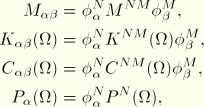
Product: ABAQUS/Standard
For structures subjected to continuous harmonic excitation, ABAQUS/Standard offers a “subspace” steady-state dynamic analysis procedure in addition to the “modal” procedure described in “Steady-state linear dynamic analysis,” Section 2.5.7, and the “direct” procedure described in “Direct steady-state dynamic analysis,” Section 2.6.1. The procedure is activated by defining a subspace-based steady-state dynamic analysis step. This procedure is a perturbation procedure, where the perturbed solution is obtained by linearization about the current base state. For the calculation of the base state the structure may exhibit material and geometrical nonlinear behavior as well as contact nonlinearities. Viscous damping can be included in the procedure using the Rayleigh damping coefficients specified under the material definition. The procedure can also be used for viscoelastic material modeling (“Frequency domain viscoelasticity,” Section 4.8.3). Discrete damping (such as dashpots) can be included. The main advantage of this method is that it allows frequency-dependent behavior to be considered at a relatively small cost increase over the purely linear analysis via the “modal” procedure described in “Steady-state linear dynamic analysis,” Section 2.5.7.
The discretized form of the linearized dynamic virtual work equation for a solid or structural system can be written as
where the following definitions apply:
The eigenfrequency step prior to the subspace-based steady-state dynamic analysis has extracted ![]() eigenmodes of the undamped system using
eigenmodes of the undamped system using
![]()

For harmonic excitation and response we can write
![]()
![]()
![]()
The equation is solved for the real and imaginary part of the complex modal amplitudes ![]() , and Equation 2.6.2–2 can be used to compute the real and imaginary part of the nodal displacements.
, and Equation 2.6.2–2 can be used to compute the real and imaginary part of the nodal displacements.
For a coupled acoustic-structural analysis the development is similar. However, in this case the “damping” matrix also contains volumetric drag, impedance boundary, radiating boundary, and fluid-solid coupling effects. Although the original formulation of the coupled acoustic-structural eigenvalue extraction problem is unsymmetric, the equations are rearranged such that the fluid-solid coupling effects are retained without making the problem unsymmetric. The resulting modes and frequencies are associated with the coupled, undamped fluid-solid system. The subspace-based steady-state dynamic procedure will project the full, coupled, and damped acoustic-structural system of equations onto the space spanned by the set of coupled fluid-solid modes.
For an acoustic-only analysis the development is very similar to that of the solid-only case. The acoustic material damping equivalent, volumetric drag, is treated in a similar manner to solid material damping effects.
As output ABAQUS/Standard provides amplitudes and phases for all element and nodal variables at the requested frequencies. All amplitude references must be given in the frequency domain.